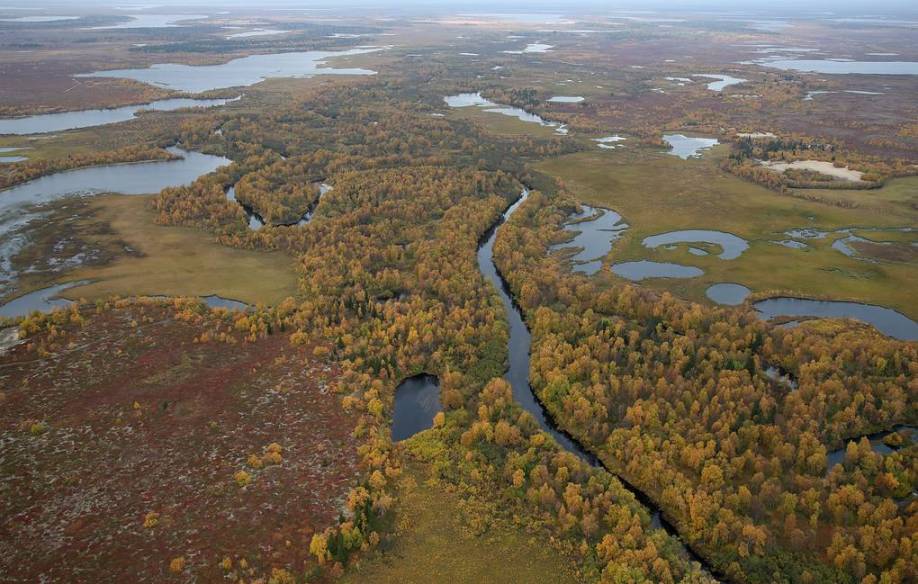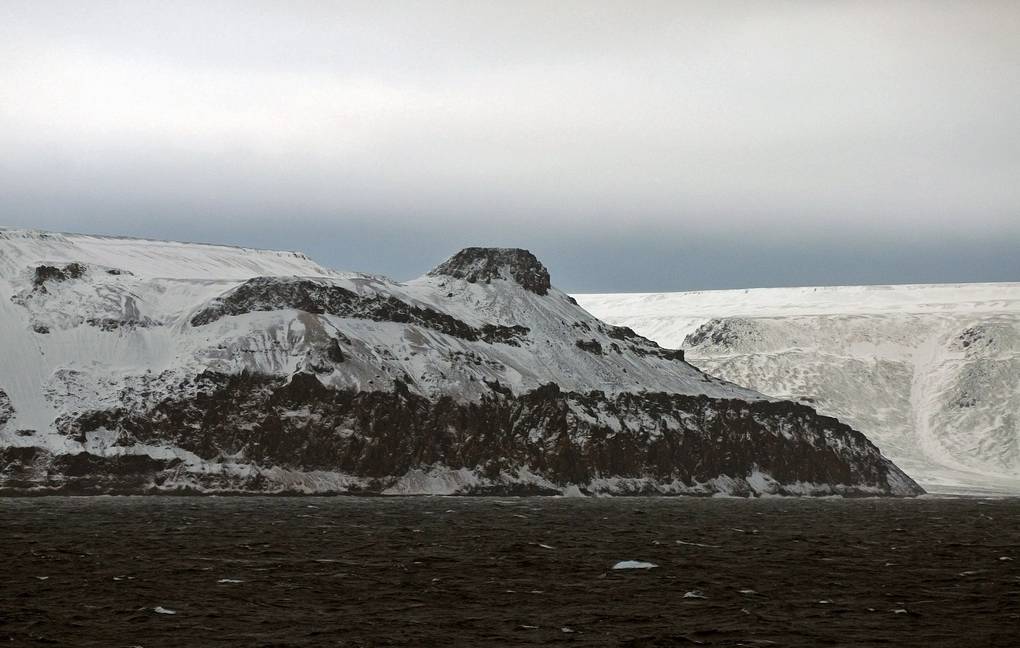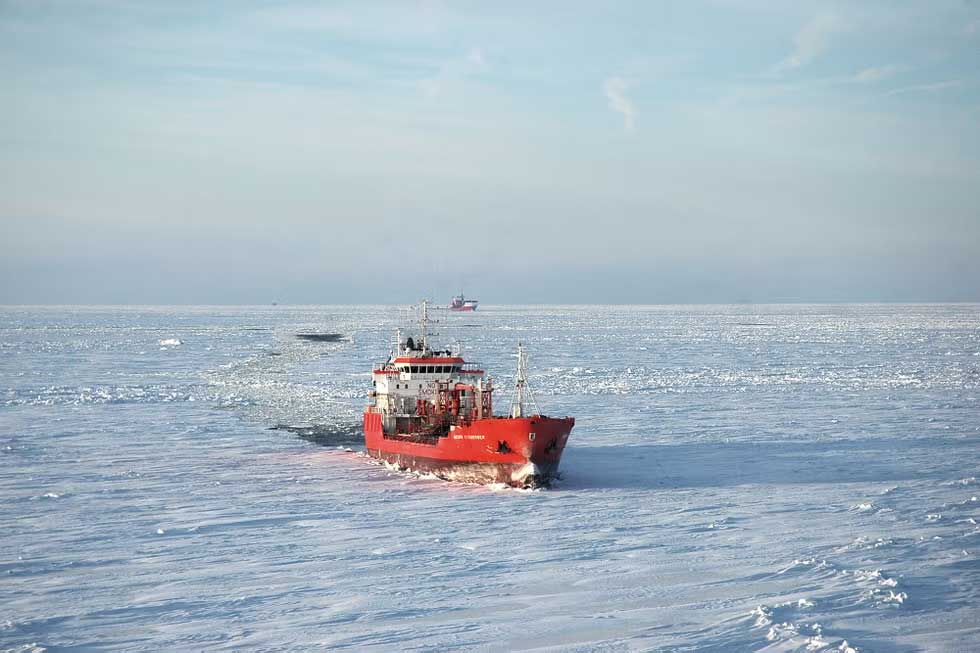Scientists from the Vernadsky Institute of Geochemistry and Analytical Chemistry (GEOKHI RAS) have discovered a harmful increase in the biological productivity of remote Arctic lakes due to global warming. Scientists have discovered plumes of smoke that periodically appear in the vicinity of Bennett Island in the East Siberian Sea. This may indicate the presence of an active volcano and a tsunami threat to Arctic villages in Yakutia. As the ice melts, new shipping routes will appear, changing the global economy. Rapidly rising temperatures and melting ice in the Arctic will affect international shipping and coastal communities around the world.
Specialists from the Vernadsky Institute of Geochemistry and Analytical Chemistry (GEOKHI RAS) have discovered a harmful increase in the biological productivity of remote Arctic lakes due to global warming, TASS reports, citing the press service of the Russian Ministry of Education and Science. It is noted that we are talking about lakes that are not subject to direct human influence, and the increase in aquatic vegetation (phytoplankton) is caused by an increase in the concentration of phosphorus, nitrogen and organic matter in the air and water.
Close reliable connections between increasing concentrations of phosphorus, nitrogen and organic matter and increasing temperature have been proven. The influence of the climatic factor on the increase in phosphorus content in the water of remote lakes has also been shown. With climate warming, another biogenic element, silicon, is also drawn into the biogeochemical cycle as a result of its absorption by intensively developing diatoms.
The work is based on a summary of data on the content of biogenic elements and organic matter in more than 100 lakes, which were studied every 5 years from 1990 to 2023 as part of the international ICP-Water program. The state of the water was assessed by such indicators as transparency, the content of total phosphorus, phosphates and chlorophyll “A” (Carlson index (TSI).

The research team came to the conclusion that in 2010–2018, the number of so-called oligotrophic lakes – that is, lakes with high water transparency, low content of organic matter, phosphorus and nitrogen, and, as a result, low bioproductivity – in the tundra zone decreased by 30% compared to the period 1990–2000. There are almost no such lakes left in the northern taiga zone.
Scientists believe that this process (the so-called eutrophication of waters) is ecologically harmful. Eutrophication of waters poses a threat to water quality due to the development of cyanobacteria – blue-green algae capable of releasing toxins into the water, as well as the overgrowing of the banks with aquatic vegetation.
Similar processes have been noted in remote lakes in the United States, which are also not subject to direct anthropogenic impact. Indirect human impact still plays a role, since large amounts of phosphorus in fertilizers around the world are washed off fields into rivers and the ocean and dispersed with dust. The results of the study are published in the journal Ecohydrology.
There may be volcanoes near the Arctic island of Bennett. Candidate of biological sciences, polar explorer Nikolai Nakhodkin reported that this could also pose a tsunami threat to Arctic settlements in Yakutia.
Scientists have discovered plumes of smoke that periodically appear in the vicinity of Bennett Island in the East Siberian Sea. This may indicate the presence of an active volcano and a tsunami threat to Arctic settlements in Yakutia, polar explorer Nikolai Nakhodkin, a candidate of biological sciences, told TASS.
In 2022, the participants of the first expedition on inflatable catamarans sailed autonomously through the islands of Bolshoy and Maly Lyakhovsky, the Anzhu group of islands, covering more than 1 thousand km along the Laptev Sea and the East Siberian Sea. Modern researchers repeated the route of Lieutenant Alexander Kolchak, who in 1903 reached Bennett Island in search of the lost expedition of Baron Eduard Toll.
“According to our observations, sometimes huge plumes of smoke emerge in the vicinity of Bennett Island. The satellite shows that they reach Canada and Alaska. This gives reason to assume that there is possibly an active volcano in the north of Yakutia,” Nakhodkin said.
In his opinion, the Academy of Sciences of Yakutia has every reason to conduct intensive research there. “Firstly, we have proven ourselves that at a distance of 1,000 km from the coast, from Tiksi, the ocean is free of ice. If open water coincides with the time of a volcanic eruption, there will be a threat of a tsunami. In the tundra, all settlements, except Tiksi, are located on low tundra shores. They can be washed away, then there will be no development of the Arctic. Therefore, it is necessary to develop a network of seismic observations and tsunami warnings there, as has been done in some regions of the Far East,” the researcher said.

Nakhodkin noted that there were no studies or fish resources in this sector of the Arctic. “We discovered on the echo sounder that there are commercial reserves there. Entire countries live on the fishery. The republic’s budget could receive additional income. The republic needs a research vessel to conduct systematic studies of the sea shelf and islands. The front for research by biologists, paleontologists and seismologists is huge. This territory has not been systematically studied,” he believes.
The agency’s source clarified that the scientific and educational center “Sever” has become interested in research on the island.
Bennett Island is one of the least studied and most difficult to access. It is part of the De Long group of islands in the East Siberian Sea. The island was named after James Gordon Bennett, Jr., one of the sponsors of the polar expedition of the American navigator George De Long. In 1881, having abandoned the ice-crushed ship Jeannette, the navigator discovered the island, trying to get to the mainland with his crew. Three months later, De Long died near the Lena River.
After its discovery, Bennett Island became famous as part of Sannikov Land, an “oasis” among the ice, a “ghost island” in the Arctic Ocean that some explorers allegedly saw north of the New Siberian Islands. The mythical island was named after the Russian merchant and explorer Yakov Sannikov, who in 1810 was the first to report the existence of land in the North where migratory birds fly in the spring, returning with their offspring in the fall.
By 2100, the Northern Sea Route will be navigable year-round. As the ice melts, new shipping routes will open up, changing the global economy. Rapidly warmer temperatures and melting ice in the Arctic will impact international shipping and coastal communities around the world.
A new study from Peking University in China has calculated that the often frozen Northern Sea Route along the northern coast of Siberia could soon be navigable year-round for even the most ill-equipped polar vessels.
While this is bad news for life on Earth in general, navigating the Northeast (and Northwest) Passages would reduce travel distances and times, resulting in significant reductions in carbon emissions.
Throughout the 19th century, finding a shipping route through the Northwest Passage was the “white whale” of maritime adventurers and explorers. Likewise, along the northern coast of Siberia in the Eastern Hemisphere, many expeditions tried to find an icy route connecting the Atlantic and Pacific Oceans via a Northeast Passage or Northern Sea Route – at least until Swedish explorer Baron Adolf Erik Nordenskiöld succeeded in the late 19th century.
Used (partially) by the Soviet Union in the 1920s and more recently by foreign shipping companies, the Northern Sea Route remains only a seasonal option for international shipping – large sections of the route, especially between the Kara and Bering Straits, remain frozen for much of the year. But in a world steadily warming due to human-induced climate change, that won’t always be the case.

Tuomas Romu // Wikimedia Commons
According to a new study led by Pengjun Zhao, a professor in the Department of Urban and Transportation Planning at Peking University, the Northern Sea Route could become navigable year-round by 2100. This is largely because the polar regions are more susceptible to climate change due to the albedo effect – as ice melts, that previously reflective (white) surface is replaced by dark, non-reflective ocean, which in turn increases temperatures and melting.
In this new study, the experts looked at low and medium emission levels and analyzed the shipping traffic along the Northern Sea Route from 2023 to 2100. They found that all ice-going vessels would be unable to navigate the route only in the spring from 2065, and by 2100 the route would be navigable all year round. The results of the study were published in the journal Communications Earth & Environment .
“The Arctic is highly sensitive to climate change, and the retreat of Arctic sea ice is steadily accelerating due to global warming,” the paper says. “Sea ice extent, sea ice thickness, and sea ice concentration will be more sensitive to climate forcing and will decrease sharply in summer and fall… this makes possible the opening of Arctic passages.”
Zhao and his colleagues did not calculate seaworthiness by assessing the most powerful icebreakers in the world’s arsenal. Instead, they considered these scenarios for Polar Class 7 (PC7) vessels, which are described as “the least capable, limited to vessels operating in summer/fall in thin first-year ice,” according to the Center for High North Logistics (CHNL).
The expedition of the Northern Fleet and the Russian Geographical Society has discovered a fragment of Willem Barents’ ship in the Arctic. Participants of the complex expedition of the Russian Defense Ministry and the Russian Geographical Society (RGS), who returned to Murmansk from the Novaya Zemlya archipelago, have discovered fragments of the ship of the Dutch explorer Willem Barents in the Arctic, on which he made polar voyages, the press service of the Northern Fleet reported.
On Friday, an expeditionary detachment arrived in Murmansk on board the large sea dry cargo transport Yauza of the Northern Fleet, which included specialists from the fleet, the 12th Main Directorate of the Russian Ministry of Defense (GUMO), the Russian Geographical Society, as well as scientists and specialists from a number of institutes and higher educational institutions.
“The main discovery was made in the area of Barents Bay, where fragments of the ship on which the explorer Willem Barents made his polar voyages were found. We also explored Krestovaya Guba, where the first settlers settled more than 100 years ago,” the press service quotes documentary filmmaker, screenwriter, and member of the Russian Geographical Society Leonid Kruglov as saying.
He also said that the scientists had examined an ancient Pomor settlement from the 17th century, then moved to the Olginskoye settlement, from where the Russian Imperial Air Force pilot Yan Nagursky took off, searching for traces of past expeditions on these lands, including the travels of the Russian hydrographer Georgy Sedov. The expedition team completely reconstructed Nagursky’s route, conducted filming and created footage that allows one to see the Arctic through the eyes of the legendary polar explorer.
The detachment started from Belushya Guba and passed around the Severny Island of the Novaya Zemlya archipelago; in total, the participants made more than 20 landings.
“The temperature values this season were above the norm by about 12 degrees, which helped to conduct research. This expedition can truly be called complex – it involved teams of glaciologists, seismologists, geologists, hydrobiologists, as well as search groups. All materials will be transferred for detailed study to institutes, which will allow us to draw conclusions and summarize the detailed results of this season,” added the commander of the expeditionary detachment, Northern Fleet officer, Captain Second Rank Sergei Zinchenko.
The work was carried out along the coast of the entire Severny Island. Scientists from the IPE RAS were looking for traces of ancient earthquakes here, they conducted georadar studies, made an orthophotomap of the area, which allowed them to look deep into the earth. This is necessary to predict earthquakes that affect the climate of the entire Arctic region.
During the expedition, hydrobiologists from VNIIRO also worked, studying the underwater life of the Arctic directly from a boat in close proximity to the shore. This helped to explore the coastal strip, poorly studied due to its inaccessibility, since it is impossible to approach the shore on a large vessel. During the work, a set of water and zoobenthos samples was collected – this will allow us to draw scientific conclusions and, possibly, key discoveries of this season.
The complex expedition to Novaya Zemlya was a continuation of the research that began in these territories in previous seasons. During these seasons, the researchers conducted underwater research of the Kara Sea, studied animals and birds, and conducted search operations.
Joint expeditions of the Russian Geographical Society and the Northern Fleet to study the Arctic archipelagos have been conducted since 2018. Scientists, volunteers and military personnel conduct comprehensive research with grant support from the Russian Geographical Society. In 2021, the project became a laureate of the Russian Geographical Society award as the best long-term expedition in Russia.
Scientists from the Kurchatov Institute, the P. P. Shirshov Institute of Oceanology, the Russian Emergencies Ministry and the Russian Geographical Society’s underwater research center have set off for the Arctic to study the radiation state of the polar region. This was reported in a statement by the Russian Geographical Society.
“A scientific expedition on board the research vessel Akademik Mstislav Keldysh has set off for the Arctic to study the radiation state of the polar region. Specialists from the Kurchatov Institute National Center, the P. P. Shirshov Institute of Oceanology, the Russian Emergencies Ministry, and the Russian Geographical Society’s Underwater Research Center will take part in the work,” the statement said.
As part of the program for monitoring the radiation state of the Arctic region, scientists will conduct measurements with spectrometric complexes, take samples of sea water and soil in areas where hazardous objects are flooded. Research will primarily be conducted near Novaya Zemlya.
The expedition will work in the Stepovogo, Blagopoluchie, and Tcheniy bays and in previously unexplored areas of the Novaya Zemlya Depression of the Kara Sea.
Since 2015, the Russian Geographical Society’s Underwater Research Center has been conducting uniquely complex deep-sea work and participating in international research programs.
Research into underwater objects and artifacts of the World Ocean allows for the organization of scientific expeditions, the discovery of sunken ships, and the development and testing of diving and deep-sea equipment.




